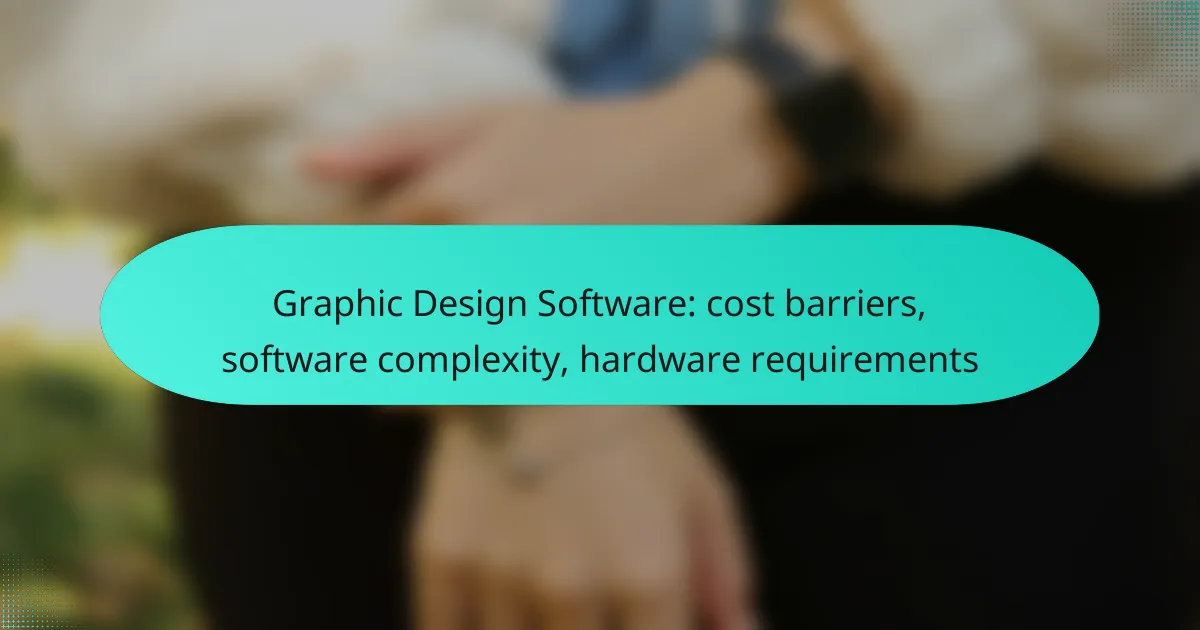Graphic design software presents various challenges, including cost barriers, complexity, and hardware requirements. In Canada, the financial aspect can fluctuate due to different pricing models, making it crucial for designers to plan their budgets wisely. Additionally, while advanced software may offer powerful features, its complexity can hinder usability, especially for beginners. Adequate hardware is also essential, as it significantly affects performance and efficiency during the design process.

What are the cost barriers of graphic design software in Canada?
The cost barriers of graphic design software in Canada can vary significantly based on subscription models, purchase options, and additional fees. Understanding these factors is essential for designers to budget effectively and choose the right tools for their needs.
Subscription pricing models
Many graphic design software options in Canada operate on a subscription basis, requiring monthly or annual payments. This model can range from low monthly fees for basic tools to higher costs for comprehensive software suites. While subscriptions provide access to the latest features, they can accumulate to a substantial yearly expense.
For example, Adobe Creative Cloud offers various plans starting from around CAD 20 per month for individual apps, while full access can exceed CAD 50 monthly. Users should weigh the benefits of ongoing updates against the long-term costs.
One-time purchase costs
Some graphic design software is available for a one-time purchase, which can be more economical in the long run. Prices for these licenses can range from a few hundred to over a thousand Canadian dollars, depending on the software’s capabilities. This option is appealing for those who prefer not to commit to ongoing payments.
However, one-time purchases may not include future updates or support, which can lead to additional costs later on if upgrades are needed.
Free vs. paid software options
Free graphic design software can be a viable option for beginners or those on a tight budget. Programs like GIMP and Inkscape offer robust features without any cost. However, they may lack the advanced functionalities and user support found in paid alternatives.
Paid software typically provides a more polished user experience, better customer service, and access to a wider range of tools, making it a worthwhile investment for professional designers.
Hidden fees and add-ons
When evaluating graphic design software, it’s crucial to consider potential hidden fees and add-ons. Some subscriptions may charge extra for additional features, cloud storage, or premium content. These costs can significantly increase the overall expense of using the software.
Always review the pricing structure carefully and factor in any anticipated add-ons to avoid surprises in your budget.
Budget-friendly alternatives
For those looking to minimize costs, there are budget-friendly alternatives to mainstream graphic design software. Tools like Canva and Figma offer free tiers with essential features, making them suitable for basic design tasks.
Additionally, exploring educational discounts or bundles can help reduce costs for students and professionals alike. Many software companies offer reduced pricing for educational institutions, which can be a great way to access premium tools at a lower price.

How does software complexity affect graphic design?
Software complexity significantly impacts graphic design by influencing usability, learning time, and the overall creative process. More complex software can offer advanced features but may also create barriers for users, particularly beginners, who may struggle to navigate intricate interfaces.
User interface design
User interface design plays a crucial role in how effectively a graphic designer can work. A well-designed interface simplifies navigation and allows users to access tools quickly, enhancing productivity. Conversely, a cluttered or unintuitive interface can lead to frustration and wasted time, particularly for those new to the software.
Learning curve for beginners
The learning curve for graphic design software varies widely, with some programs being more user-friendly than others. Beginners may find software with simpler interfaces easier to learn, while more complex tools can require significant time investment to master. It’s essential for new users to choose software that aligns with their skill level to avoid discouragement.
Feature sets of popular software
Popular graphic design software often comes with a range of features that cater to different needs. For instance, Adobe Creative Cloud offers extensive tools for professional designers, including advanced image editing and vector graphics capabilities. In contrast, alternatives like Canva focus on ease of use with templates and drag-and-drop functionality, making them suitable for casual users.
Comparison of Adobe Creative Cloud and Affinity Suite
Adobe Creative Cloud and Affinity Suite are two leading graphic design software options, each with distinct advantages. Adobe Creative Cloud is subscription-based, providing access to a comprehensive suite of tools, but it can be costly over time. Affinity Suite, on the other hand, offers a one-time purchase model, making it more budget-friendly while still delivering powerful features, though it may lack some advanced options found in Adobe’s offerings.

What are the hardware requirements for graphic design software?
Hardware requirements for graphic design software vary based on the complexity of the projects and the specific applications used. Generally, a capable computer will enhance performance and efficiency, allowing designers to work effectively without interruptions.
Minimum system specifications
The minimum system specifications for graphic design software typically include a multi-core processor, at least 8 GB of RAM, and a dedicated graphics card with a minimum of 2 GB VRAM. Storage should be at least 256 GB, preferably an SSD for faster load times.
These specifications allow basic functionality for software like Adobe Photoshop or Illustrator, but may lead to slower performance with larger files or more complex tasks.
Recommended hardware for optimal performance
For optimal performance, graphic designers should consider a system with a quad-core processor, 16 GB or more of RAM, and a dedicated graphics card with at least 4 GB VRAM. An SSD of 512 GB or larger is advisable to accommodate large project files and applications.
This setup will significantly improve rendering times and multitasking capabilities, making it easier to handle demanding software and large design projects.
Impact of hardware on software functionality
The hardware directly impacts the functionality of graphic design software by determining how quickly and efficiently tasks are completed. Insufficient hardware can lead to lagging, crashes, and an overall frustrating user experience.
For instance, a powerful graphics card allows for real-time rendering and smoother manipulation of high-resolution images, while adequate RAM ensures that multiple applications can run simultaneously without performance dips.
Best laptops for graphic design in Canada
Some of the best laptops for graphic design in Canada include the Apple MacBook Pro, Dell XPS 15, and Microsoft Surface Laptop 4. These models offer powerful processors, ample RAM, and high-quality displays that are essential for design work.
When selecting a laptop, consider factors such as weight, battery life, and screen resolution, as these can affect portability and usability during design sessions. Prices for these laptops typically range from CAD 1,500 to CAD 3,000, depending on specifications and features.

What criteria should be considered when choosing graphic design software?
When selecting graphic design software, consider factors such as compatibility with existing hardware, integration with other tools, and the availability of user support and community resources. These criteria will help ensure that the software meets your needs and fits seamlessly into your workflow.
Compatibility with existing hardware
Before purchasing graphic design software, check its compatibility with your current hardware. Most software has minimum system requirements regarding processor speed, RAM, and graphics capabilities. For instance, software like Adobe Photoshop typically requires at least 8 GB of RAM and a multi-core processor for optimal performance.
Additionally, consider whether your hardware can handle updates or newer versions of the software. If your computer is several years old, you may need to upgrade components or even invest in a new machine to run the latest design applications effectively.
Integration with other tools
Integration with other design tools and software can significantly enhance your workflow. Look for graphic design software that can easily connect with applications like Adobe Creative Cloud, Sketch, or Figma. This compatibility allows for smoother transitions between tasks and better collaboration with team members.
Evaluate how well the software supports file formats and whether it can import/export files to and from other tools you use. This capability can save time and reduce frustration when working on projects that require multiple applications.
User support and community resources
Effective user support and a robust community can make a significant difference in your experience with graphic design software. Check if the software provider offers comprehensive documentation, tutorials, and responsive customer support. This can be particularly helpful when troubleshooting issues or learning new features.
Additionally, explore community forums, social media groups, and online tutorials. A strong user community can provide valuable insights, tips, and resources that enhance your skills and help you maximize the software’s potential.

What are the emerging trends in graphic design software?
Emerging trends in graphic design software include the integration of AI-driven tools, enhanced cloud-based collaboration features, and improved cross-platform accessibility. These advancements are reshaping how designers create, share, and collaborate on projects, making the process more efficient and user-friendly.
AI-driven design tools
AI-driven design tools leverage machine learning to automate repetitive tasks and provide intelligent suggestions, streamlining the creative process. For instance, software like Adobe Sensei can analyze design elements and offer layout recommendations, significantly reducing the time spent on adjustments.
When considering AI tools, evaluate their ability to integrate with existing software and the learning curve involved. While these tools can enhance productivity, they may require some initial training to fully utilize their capabilities.
Cloud-based collaboration features
Cloud-based collaboration features allow multiple users to work on a design project simultaneously, regardless of their physical location. Tools like Figma and Adobe XD enable real-time editing and feedback, which can accelerate project timelines and improve team communication.
To maximize the benefits of cloud collaboration, ensure all team members are familiar with the platform’s functionalities. It’s also essential to establish clear guidelines for version control to avoid confusion and maintain project integrity.
Cross-platform accessibility
Cross-platform accessibility ensures that graphic design software can be used on various devices and operating systems, enhancing flexibility for designers. Many modern applications are now available on both desktop and mobile platforms, allowing users to work seamlessly across devices.
When selecting software, consider compatibility with your team’s preferred devices and operating systems. This can prevent potential issues and ensure that all team members can contribute effectively, regardless of their hardware. Additionally, check for any subscription costs associated with accessing features across different platforms.
